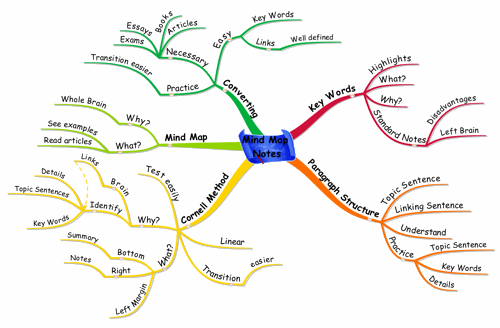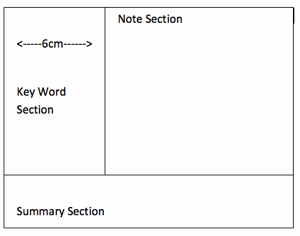Use Mind Map Notes to involve your whole brain...
'Mind Map Notes' was the first application of Mind Maps. The creation of Mind Maps gave rise to the verb Mind Mapping.
Mind Mapping as an alternative to Linear Notes became the main selling point of Mind Maps.
This article introduces you to Mind Map Notes by taking you through a scenario of Janet's notes. Janet is a fictitious character, so any resemblance to you is purely coincidental. Her case study also introduces you to important information about sentence and paragraph construction that will make your note taking far more effective.
Subscribe to Using Mind Maps
Get Access to the Best Mind Mapping Tips, Tools, Techniques Resources and Opinions.

1. Key Words
Janet's beautiful highlights
No, I’m not talking about her hair, although that looks great too!
Janet always highlighted important information. If she owned the textbook, she would highlight directly in the book. If she didn't, she would make notes and highlight those. Everything was important, so everything was highlighted! She also believed that a yellow highlighter worked best as it “stands out”. Picture a yellow highlighted page - I'm sure you've seen this before!
Janet has always been a prolific note taker. She prided herself in having the best notes in class. Her notes were almost accurate reflections of her text books and lectures. She recorded many of her teachers’ words verbatim. In fact, many teachers praised her excellent notes. They had never seen anything like it and constantly used her notes as an example for other students.
There was one major problem though; Janet was not a top student. In fact, she was a rather poor student. She barely scraped through some of her exams, yet she constantly won the ‘most dedicated’ and ‘hardworking’ prizes.
Then Janet discovered Key Words! Suddenly her note taking volumes were reduced by as much as 90%. No, this is not a typing mistake! With a little practice, you could too. Not only did the volumes decrease, but the time taken to make the notes also dramatically decreased. She could now spend more time on revising (and admiring her other beautiful highlights). Her results improved dramatically, even though she was now spending less time on her notes.
What are Key Words? They are strong nouns or verbs that create images to trigger recall. Used in a Mind Map or the Cornell Method of Note Taking, it also helps to recall the context, as it provides hooks to other words.
It is important to choose Key Words that trigger recall. Practice by choosing Key Words for a paragraph. Put the paragraph out of sight and see whether you can recall the paragraph from the Key Words.
Why use Key Words? The first obvious reason is that it’s a great time saver! Words like ‘the, and, is, etc.’ add no value and don’t help the brain to remember. They actually obscure the Key Words and prevent the brain from remembering.
Key Words are also the seeds for intuitive association. It is a known fact that strong association is the key to perfect recall.
The creative brain adds context to the Key Words in its own words and pictures. This takes the learner to a new level of understanding.
In the past emphasis was placed on remembering facts and content, while it is actually the underlying concepts that are important. Distilling something to its Key Word state enables the underlying concepts to be understood and, more importantly, remembered. With information multiplying so rapidly, Key Words help us to conceptualise the important points.
Disadvantages of Standard Notes:
- Time wasted on recording irrelevant words (Up to 90%)
- Time wasted re-reading the same irrelevant words (Up to 90%)
- Time wasted in searching for the relevant Key Words
- Connections between Key Recall Words are interrupted by these irrelevant words. MEMORY WORKS BY ASSOCIATION!
- These irrelevant words cause a time lag between Key Words. This prevents quick association
- There is a greater distance between Key Words. The further they are apart, the more difficult the association
- Practice, Practice, Practice!
- Start by looking at some of your own notes
- Do about a page or two at a time
- Write down the words you think are Key Words
- Put your notes away
- Write sentences from your Key Words
- How closely does it represent the original concepts?
- Repeat for some more notes until you are happy that you can easily do the above
2. Paragraph Structure
Paragraph Structure
A well constructed paragraph is a series of sentences that are organised and coherent, and are all related to a single topic.
As a paragraph should relate to a single topic, it should have a single, controlling sentence called the topic sentence. This sentence is more often than not, the first sentence and has a few important functions:
- It supports the message of the chapter/section which contains it
- It unifies the content of the paragraph
- It directs the order of the sentences
- It advises the reader of the subject it will discuss and how it will discuss it
Topic Sentence
A topic sentence is a sentence whose main idea controls the rest of the paragraph.
If a paragraph is well constructed, it would generally have a topic sentence, with the rest of the paragraph supporting the topic sentence.
It is often the first sentence in a paragraph.
In a coherent paragraph each sentence supports and relates to the controlling idea contained in the topic sentence. A coherent paragraph normally 'flows' smoothly and is consistent with it's point of view.
It often contains a linking sentence as the first sentence to link it to the previous paragraph. The Topic Sentence normally follows the Linking Sentence.
Why discuss paragraph structure?
By understanding paragraph structures, you ensure that you are getting the correct message and also that you are taking down what's important.
You should also be able to see whether a paragraph is poorly constructed and perhaps divide it into two or more topic sentences.
Once you've done this, you are guaranteed that all important information is being recorded.
Once your topic sentences are identified, you can reduce it to Key Words. These Key Words can be supported by other Key Words, which make up the rest of the paragraph.
Practice
- Take a simple passage initially, even if it's from a magazine
- Write down the topic sentence in each paragraph
- Reduce each topic sentence to key words or phrases
- Look for key words or phrases that support the topic sentence and write this down
By doing this you will ensure that you know how to extract the important information when taking notes. By reducing the Topic Sentences to Key Words, you are well on your way to becoming an expert note taker!
3. Cornell Method
We use a Linear Note taking method to help you learn how to create Mind Map Notes. For many people, the transition to solely Mind Map Notes is too radical. The vast majority end up using a combination of Linear Notes and Mind Map Notes. If you are going to use both, we highly recommend that you use the Cornell Method for your Linear Notes.
What is the Cornell Method?
The Cornell Note Taking Method was invented in the 1950s by Professor Walter Pauk at Cornell University in New York.
The system (using A4 paper, or U.S. Letter) consists of three parts:
- A left hand margin of about 6cm
- A note taking section on the Right Hand Side
- A summary section at the bottom of four lines or about 4-5cm in height.

The topic sentences go in the right hand side, followed by supporting sentences if need be. The topic sentence can also be summarised if so desired.
On the left hand side are Key Words, which should trigger recall of the topic sentence.
Questions could also be placed on the left hand side and the answers on the right hand side.
A summary of the page or topic is written in the footer section.
Why does it work?
- Topic Sentences and Key Words are easily identifiable.
- The link between the Key Words and the Topic Sentences are enforced
- The brain only has to focus on what is necessary
- You can test yourself easily by covering up the right hand side and trying to recall the right hand side
4. Mind Map Notes
What is a Mind Map?
A Mind Map is a 'whole brain' note taking method. The two sides of the brain will be covered in more details elsewhere. All you need to know for now is that there is a creative (right) side and a logical (left) side to the brain.
Mind Map Notes cater for both sides. Traditional linear notes cater mainly for the logical side.
A Mind Map consists of a Central Topic with a Central Picture. This is very important, as it forms a 'hook' to which all the information it contains will be attached.
Attached to the Central Topic are thick Main branches. These branches are often the headings in a text book.
Attached to the Main Branches are thinner Sub Branches followed by Detail Branches.
We promote Mind Map notes as a complementary Note Taking method to the Cornell Method, even though we would like you to eventually use Mind Mapping as you main, if not your only, Note Taking method.
Advanced Mind Mapping is the subject of a different set of articles and courses.
For now, we simply want you to use Mind Map Notes for your overviews and summaries and to help you to remember Key Concepts.
Why do Mind Map Notes work?
- It stimulates the brain by appealing to both the creative and logical side of the brain.
- It allows Key Words to be easily identified.
- Strong connections are maintained between ideas.
- It can reduce your quantity of notes by more than 90%.
5. Converting Cornell to Mind Map Notes and Vice-Versa
We strongly recommend that you practice converting between Mind Map Notes and Cornell Notes in the beginning. This enable you to make the Linear to Mind Map transition easier. Even if you are using Mind Maps to study prepare for exams, you will probably have to answer in linear format. Knowing to convert from one to the other therefore makes perfect sense.
Also, if you are intending to write books, essay and articles, you have to convert your Mind Map Notes to linear format.
The process of converting between the two note taking methods should be quite easy.
Both contain Key Words and the links between words are strong and well defined.
The Topic Sentences of the Cornell Method become the Main Branches in a Mind Map and the Key Words become the Sub Branches and Detailed Branches.
By having both Cornell and Mind Map Notes you maximise your brain's potential to comprehend and remember.
While we believe that Using Mind Maps for your Notes is the best possible way to take notes, throwing out Linear completely, especially in the beginning, may be throwing the baby out with the bath water. Click here to learn about our unique Learning Management Program...
Return from Mind Map Notes to Using Mind Map home page


